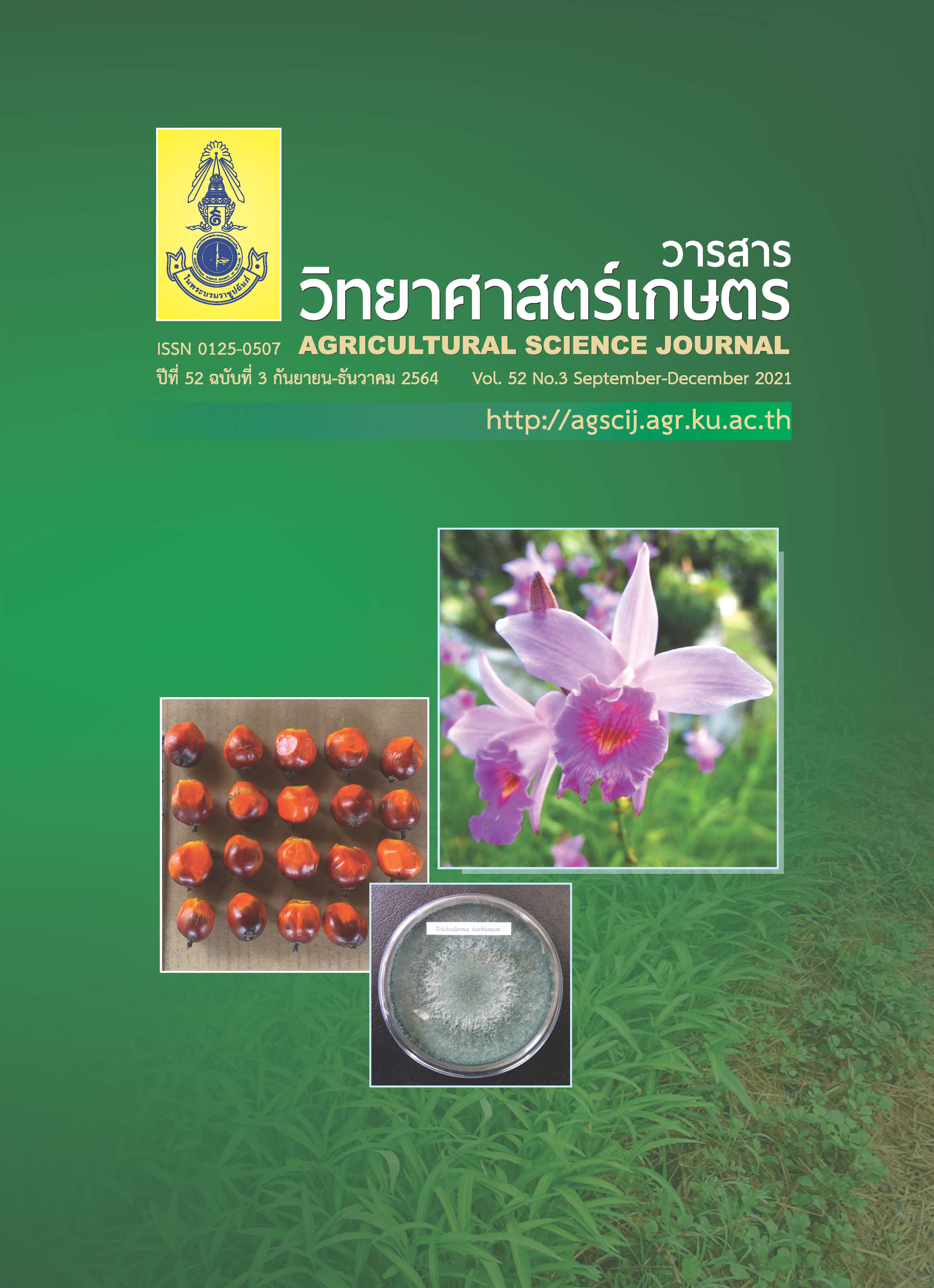ผลของไนโตรเจนต่อดัชนีการเติบโต ผลผลิตและคุณภาพน้ำมันปาล์มดิบของปาล์มน้ำมันที่ปลูกในดินเปรี้ยวจัดทุ่งรังสิตในที่ราบภาคกลางของประเทศไทย
Main Article Content
บทคัดย่อ
การตอบสนองของปาล์มน้ำมันต่ออัตราไนโตรเจนเป็นแนวทางในการให้คำแนะนำปุ๋ยไนโตรเจนอย่างมีประสิทธิภาพสำหรับปาล์มน้ำมันที่ปลูกในดินเปรี้ยวจัด การศึกษานี้มีวัตถุประสงค์เพื่อศึกษาผลของปุ๋ยไนโตรเจนต่อการเติบโตและผลผลิตของของปาล์มน้ำมันที่ปลูกในดินเปรี้ยวจัดทุ่งรังสิต โดยวางแผนการทดลองแบบสุ่มสมบูรณ์ภายในบล็อก มีอัตราปุ๋ยไนโตรเจน 6 ตำรับทดลอง จำนวน 2 ซ้ำ (df = 11) ได้แก่ 0, 150, 300, 600, 750 และ 900 กรัมไนโตรเจนต่อต้นต่อปี โดยทำการทดลองในดินเปรี้ยวจัด 3 บริเวณ ได้แก่ ชุดดินรังสิต 2 บริเวณ และชุดดินองครักษ์ 1 บริเวณ ในจังหวัดนครนายกและสระบุรี โดยศึกษาการตอบสนองด้านการเจริญเติบโต ผลผลิต และคุณภาพน้ำมันปาล์ม ผลการศึกษา พบว่า ปาล์มน้ำมันตอบสนองต่ออัตราปุ๋ยไนโตรเจนด้านการให้ผลผลิตทะลายแห้ง (P = 0.031) และผลผลิตทะลายสดต่อไร่ (P = 0.031) และดัชนีทะลาย (P = 0.026) แตกต่างกันอย่างมีนัยสำคัญ โดยการใส่ปุ๋ยไนโตรเจนในอัตราสูงตั้งแต่ 600–900 กรัมไนโตรเจนต่อต้นต่อปี สามารถเพิ่มผลผลิตทะลายได้สูงกว่าการใส่ปุ๋ยไนโตรเจนอัตราต่ำกว่า 600 กรัมไนโตรเจนต่อต้นต่อปี และสามารถเพิ่มความเข้มข้นของไนโตรเจนในใบปาล์มที่ 17 ให้สูงขึ้นอยู่ในระดับเพียงพอ นอกจากนี้ อัตราปุ๋ยไนโตรเจนที่เพิ่มขึ้นไม่ทำให้คุณภาพของน้ำมันปาล์มแตกต่างกันอย่างมีนัยสำคัญ การตอบสนองต่อปุ๋ยไนโตรเจนของปาล์มน้ำมันแตกต่างกันระหว่างพื้นที่ศึกษา แสดงให้เห็นว่า สภาพแวดล้อมและการจัดการปาล์มน้ำมันเฉพาะพื้นที่และระดับไนโตรเจนในดินมีผลต่อการตอบสนองต่อปุ๋ยไนโตรเจน ผลการวิจัยเสนอแนะว่า การใส่ปุ๋ยไนโตรเจนอัตรา 600 กรัมไนโตรเจนต่อต้นต่อปี สามารถรักษาผลผลิตทะลายปาล์มอยู่ในระดับสูง ทั้งนี้ ควรรักษาสมดุลและอัตราส่วนของ N:K2O:P2O5 ให้เท่ากับ 1:3:0.77
Article Details
เอกสารอ้างอิง
Auxtero, E.A. and J. Shamshuddin. 1991. Growth of oil palm (Elaeis guineensis) seedlings on acid sulfate soils as affected by water regime and aluminium. Plant Soil. 137: 243–257.
Bustamam, F.K.A., Y.C. Beng and N. Sulaiman. 2019. Revision of the Malaysian standard for palm oil-specification MS 814:2007, (second revision) amendment 1:2018 - what’s new?. Palm Oil Developments. 71: 18–32.
Chittamart, N., A. Suddhiprakarn, W. Wisawapipat, S. Tawornpruek, K. Laopoolkit, S. Aramrak, T. Darunsontaya, D. Ketroj, R. Jaroenchasri and I. Kheoruenromne. 2016. Management of Sustainable Yield Increase and Waste Utilization of Oil Palm in Central Plain and Eastern Region, Thailand. Agricultural Research Development Agency (ARDA), Bangkok, Thailand. (in Thai)
Corley, R.H.V. and C.K. Mok. 1972. Effects of nitrogen, phosphorus, potassium and magnesium on growth of the oil palm. Exp. Agric. 8(4): 347–353.
Corley, R.H.V., J.J. Hardon and G.Y. Tan. 1971. Analysis of growth of the oil palm (Elaeis guineensisjacq.) I. Estimation of growth parameters and application in breeding. Euphytica. 20: 307–315.
Donough, C.R., A. Cahyo, R. Wandri, M. Fisher and T. Oberthür. 2016. Plant nutrients in palm oil. Better Crops. 100(2): 19–22.
Edy, N., U. Yelianti, B. Irawan, A. Polle and R. Pena. 2020. Differences in root nitrogen uptake between tropical lowland rainforests and oil palm plantations. Front. Plant Sci. 11: 92.
Estefan, G., R. Sommer and J. Ryan. 2013. Methods of Soil, Plant, and Water Analysis: A Manual for the West Asia and North Africa Region. 3rd edition. International Center for Agricultural Research in the Dry Areas (ICARDA), Beirut, Lebanon.
Fairhurst, T.H. and E. Mutert. 1999. Interpretation and management of oil palm leaf analysis data. Better Crops International. 13(1): 48–51.
Japir, A.A.-W., J. Salimon, D. Derawi, M. Bahadi, S. Al-Shuja’a and M.R. Yusop. 2017. Physicochemical characteristics of high free fatty acid crude palm oil. OCL. 24(5): D506.
Lawlor, D.W. and G. Cornic. 2002. Photosynthetic carbon assimilation and associated metabolism in relation to water deficits in higher plants. Plant Cell Environ. 25(2): 275–294.
Lewis, K., E. Rumpang, L.K. Kho, J. McCalmont, Y.A. Teh, A. Gallego-Sala and T.C. Hill. 2020. An assessment of oil palm plantation aboveground biomass stocks on tropical peat using destructive and non-destructive methods. Sci. Rep. 10: 2230.
Mahesar, S.A., S.T.H. Sherazi, A.R. Khaskheli, A.A. Kandhro and S. Uddin. 2014. Analytical approaches for the assessment of free fatty acids in oils and fats. Anal. Methods. 6: 4956–4963.
May, C.Y. 1994. Palm oil carotenoids. Food Nutr. Bull. 15(2): 1–8.
McMurtrie, R.E. and T. Näsholm. 2018. Quantifying the contribution of mass flow to nitrogen acquisition by an individual plant root. New Phytol. 218: 119–130.
Mohidin, H., M.M. Hanafi, Y.M. Rafii, S.N.A. Abdullah, A.S. Idris, S. Man, J. Idris and M. Sahebi. 2015. Determination of optimum levels of nitrogen, phosphorus and potassium of oil palm seedlings in solution culture. Bragantia. 74: 247–254.
Ng, S.K. 2002. Nutrition and nutrient management of the oil palm - New thrust for the future perspective, pp. 415–429. In N.S. Pasricha and S.K. Bansal, eds. Potassium for Sustanable Crop Production: International Symposium on Role of Potassium. Potash Research Institute of India and International Potash Institute, New Dehli, India.
Nokkaew, R., V. Punsuvon, T. Inagaki and S. Tsuchikawa. 2019. Determination of carotenoids and dobi content in crude palm oil by spectroscopy techniques: comparison of Raman and FT-NIR spectroscopy. Int. J. GEOMATE. 16(55): 92–98.
Office of Agricultural Economics. 2019. Agricultural economic data: oil palm prodution data. Available Source: https://www.oae.go.th, September 24, 2021.
Pardon, L., C. Bessou, P.N. Nelson, B. Dubos, J. Ollivier, R. Marichal, J.P. Caliman and B. Gabrielle. 2016. Key unknowns in nitrogen budget for oil palm plantations. A review. Agron. Sustain. Dev. 36: 20.
Puritch, G.S. and A.V. Barker. 1967. Structure and function of tomato leaf chloroplasts during ammonium toxicity. Plant Physiol. 42(9): 1229–1238.
Rifqi Hidayat, A. and A. Fahmi. 2020. Impact of land reclamation on acid sulfate soil and its mitigation. BIO Web Conf. 20: 01002.
Sahrawat, K.L., G. Ravi Kumar and K.V.S. Murthy. 2002. Sulfuric acid–selenium digestion for multielement analysis in a single plant digest. Commun. Soil Sci. Plant Anal. 33(19–20): 3757–3765.
Shamshuddin, J., S. Muhrizal, I. Fauziah and M.H.A. Husni. 2004. Effects of adding organic materials to an acid sulfate soil on the growth of cocoa (Theobroma cacao L.) seedlings. Sci. Total Environ. 323(1–3): 33–45.
Tan, K.S. 1976. Development, Nutrient Contents and Productivity in Oil Palm on Inland Soils of West Malaysia. MS Thesis, University of Singapore, Singapore.
Tantanawat, T., S. Srimongkol, R. Yuttawiriya, A. Haewchin, T. Sangkapes and E. Hattha. 2020. Development of a method for measuring oil content in oil palm mesocarp using a single-outlet piston press: a feasibility study. J. Food Meas. Charact. 14: 207–219.
Teh, C.B.S. 2016. Availability, Use, and Removal of Oil Palm Biomass in Indonesia. Report Prepared for the International Council on Clean Transportation.
Tobing, W.L., C. Hanum and E.S. Sutarta. 2018. Growth response and nitrogen use efficiency of palm oil variety on N fertilizing in pre nursery. Agric. 30(1): 43–50.
Ukom, A.N., P. Ojimelukwe and D.A. Okpara. 2009. Nutrient composition of selected sweet potato [Ipomea batatas (L) Lam] varieties as influenced by different levels of nitrogen fertilizer application. Pak. J. Nutr. 8(11): 1791–1795.
Vosawai, P., R.A. Halim and A.R. Shukor. 2015. Yield and nutritive quality of five sweet potato varieties in response to nitrogen levels. Adv. Plants Agric. Res. 2(5): 231–237.
Widodo, P., F. Nur, E. Nafisah, B.P. Forster and H.A. Hasibuan. 2019. Bunch and Oil Analysis of Oil Palm: A Manual. CABI, Wallingford, UK.


